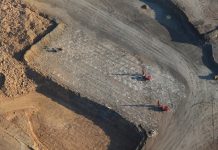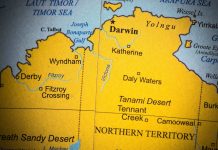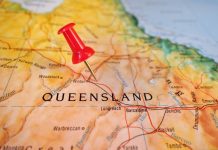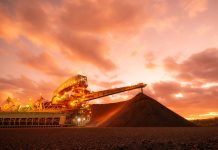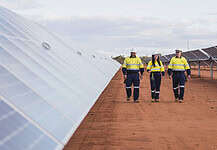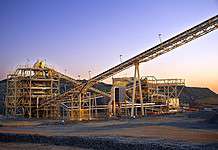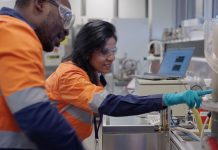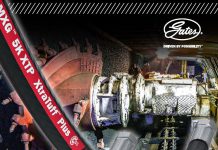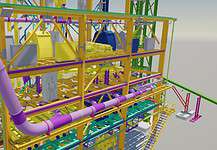
By Emma Brown
September 11, 2015
The Shire of Cobar is often referred to as the ‘Copper City’, thanks to its extensive history of copper mining that stretches back to 1869. However with highly-prospective poly-metallic operations currently underway, the area is proving a life outside of copper is possible.
TODAY Cobar, which lies in the centre of NSW at the crossroads of the Barrier Highway and the Kidman Way, is a major NSW metalliferous centre, ranking second only to Broken Hill in renowned and continuing importance.
Cobar continues to be a major exploration zone targeting copper, gold, silver and zinc.
Cobar mayor Lilliane Brady said the mining industry was the shire’s backbone.
“Mining is what keeps Cobar going and it has done for generations,” Mrs Brady said.
“We’ve got six mines in our shire and each of them represents profit and employment.
“Our lives revolve around the mine and the mines are important to the community of Cobar.”
Flying in the face of the recent downturn and falling commodity prices, Mrs Brady said Cobar now had more mines in operation than ever before.
“Six mines is the most that has been in operation in the 45 years I’ve lived in Cobar,” she said.
Mrs Brady said the shire of Cobar was different to the majority of shires in NSW because of the mining industry.
“The Cobar shire is the fifth largest area in a small country town and we contribute between $25 million and $30 million in royalties a year,” she said.
“Mining accounts for the majority of the shire’s income; if it wasn’t for the mines the town would be dead.”
CSA Mine
Operations at CSA mine began in 1871, however large-scale production wasn’t achieved until Broken Hill South took over the operations in 1964.
After several changes in ownershipCSA was placed on care and maintenance in 1998, as a result of financial difficulties including inefficient working practices and a slump in metal prices due to the Asian financial crisis.
“The closure of CSA was disastrous for our community, at the time,” Mrs Brady said.
“But like all country mining towns, we stick together, we fundraised and we got through it.”
Operations resumed in 1999 under Cobar Management, a wholly-owned Australian subsidiary of Glencore.
In the past the mine has produced substantial amounts of lead, zinc and silver, however today the CSA underground mine focuses on copper, with a silver co-product.
It produces more than 1.1 million tonnes of copper ore and more than 185,000t of copper concentrate per annum. The concentrate is exported to smelters in India, China and South East Asia.
In May 2015 Downer was awarded $70 million, two-year contract for mining services at the CSA mine. The scope of works includes mechanised decline and lateral development mining and haulage, and the provision of ground support services.
The mine employs more than 300 people, plus contractors, the majority of which are based within the shire.
Endeavor Mine
CBH Resources’ underground zinc, lead and silver Endeavor Mine, 47km north of Cobar, began operations in 1983 under the name Elura Mine.
CBH Resources acquired the mine in 2003 and changed its name. Since then, both the mine and processing plant have been upgraded.
In response to the 2008 global financial crisis and depressed metals markets, production was cut to 420,000 tonnes per annum of ore to ensure the operation remained viable.
However, since then Endeavor’s output has increased to 720,000tpato produce about 44,000t of zinc metal in concentrate and 24,000t of lead metal in concentrate. Endeavor also produces 24,000kg of silver contained in the lead concentrate.
This production level is expected to support the mine’s life for about six years, however CBH is actively exploring in and around the mine to further add to its resource base.
Peak Gold Mines
New Gold owned operation Peak Gold Mines (PGM) consists of five producing gold and copper underground deposits: Peak, New Occidental, New Cobar, Perseverance and Chesney, within the greater Cobar Gold Field on the eastern margin of the Cobar Basin.
Production at the operations began in 1992, with New Gold producing gold ore for the Perth Mint and copper concentrate for export to Asia.
Gold production at PGM during the second quarter of 2015 gold was significantly lower than the prior-year quarter, at 14,892oz. This was due to a number of factors including less tonnes processed, and a lower gold grade and recovery.
Activity at the Perseverance deposit in the first half of 2015 focused on rehabilitation and remediation of the area following geotechnical challenges experienced in March which resulted in a decrease in tonnes mined.
However, activity picked up by the end of the second quarter with operation reaching between 60 and 70 per cent of historical levels.
The disturbance at Perseverance turned New Gold’s focus to PGM’s copper-rich ore bodies – Chesney and New Cobar.
The June quarter copper production of 3.7 million pounds was 800,000lb below the prior-year quarter, although the copper grade remained consistent.
Overall gold production at PMG for the six month period ending June 2015 was 34,320oz, lower than what was achieved in the same period in 2014. Gold production in the second half of 2015 is expected to increase significantly as remediation of Perseverance continues.
New Gold advised that PGM was expected to reach close to the low end of the production guidance range of between 85,000oz and to 95,000oz.
Copper production for the same period was 7.1mlb, a drop from 8.4mlb the previous year. Copper production is expected to remain consistent with the first half for the remainder of the year.
Hera-Nymagee
Aurelia Metals’ Hera-Nymagee project consists of the Hera gold-base metal deposit and the Nymagee copper deposit. Aurelia stated that both the Hera and Nymagee deposits have the potential to evolve into a very large “Cobar style” mineral system similar to Glencore’s CSA mine.
The technical and financial viability of the Hera deposit was confirmed with a definitive feasibility study completed in June 2011. About a year later the project received state government approval and commercial production began in April 2015.
Aurelia reported a lower than expected performance at the site during the June 2015 quarter due to a range of mechanical and technical issues which affected gold and zinc recovery, processing, throughput and processing costs.
In July, Aurelia released the result of the Hera Expansion Study, an option being considered to improve performance of the processing circuit by lowering operating costs and increasing the capacity up to 450,000tpa.
The study showed the Hera project would have a five year mine life at an average annual production of 40,000oz of gold, 14000tof zinc and 12,5000t of lead. The study is contingent on securing external funding and an amendment to the project’s existing approval for increased annual mining rates.
Aurelia is progressing development and feasibility programs to incorporate the Nymagee copper ore. The deposit is emerging as one of the most exciting copper discoveries in Australia in recent times.
Conclusion
While a large proportion of the mining workforce is based in community of Cobar, Mrs Brady said that fly in, fly out workers were more prominent now than ever. With more mines operating now than ever before in Cobar, the town itself will continue to change in the face of an evolving industry.
Mrs Brady said that while the use of fly in, fly out workers was clearly the way of a future, this type of workforce also had a big impact on the community.
“People are no longer moving to the town with their families, which has had a knock on effect on the numbers in our schools and hospitals.
“FIFO workers are also in the mines working 12 hour shifts before they go home to bed, which means they are also spending very little in the town.”
The Shire of Cobar is also home to Black Oak Minerals’ Mt Bobby gold mine and Manuka silver project.

